1975 French Grand Prix race report
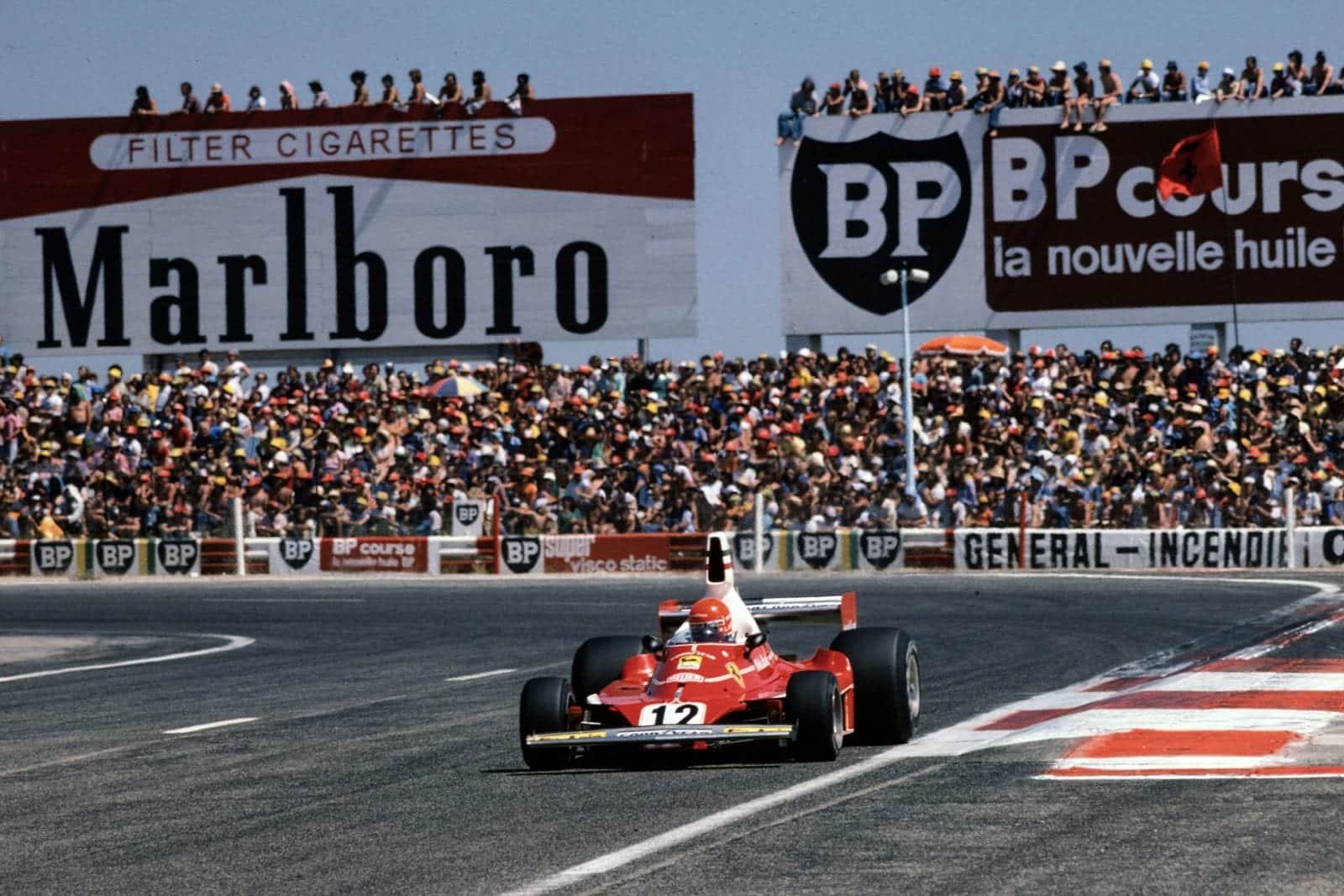
Ferrari's Niki Lauda scored his fourth win of the season at Paul Ricard
Motorsport Images
Runaway win for Ferrari
Paul Ricard, Castellet, July 6th
The outcome of the French Grand Prix was made abundantly clear just before practice ended on Saturday afternoon when Niki Lauda showed his hand with the Ferrari, having been playing along with the Cosworth-powered brigade and showing little superiority. On Friday it had been Jarier with the Shadow who was setting the pace and on Saturday morning Hunt was fastest with the Hesketh, the times in the mid one minute forty-eight second bracket. No-one had looked like getting below 1 min. 48 sec., so that when Lauda suddenly put in two laps well below this figure, his best being 1 min. 47.82 sec., there was a general air of disbelief in the pits until the full force of the knowledge struck home.
The flat and rather uninteresting Paul Ricard circuit can be tackled from two opposing angles, or by a compromise. The layout is roughly rectangular with a long flat straight down one side, some “mickey-mouse” twists and turns at each end and a flat-out ess-bend in the middle of the other leg. You can either opt for maximum speed at the expense of cornering power, or sacrifice speed and concentrate on cornering, the choice being made by aerodynamic adjustments, the aerofoil settings for maximum down-thrust through the corners losing you maximum speed on the straight by reason of the increased drag. Some team engineers were in favour of concentrating on flat-out speed, but their drivers were more interested in cornering, while others were trying to achieve a balance between the two. Depending on the angles of the aerofoils the maximum speed on the long straight could vary between something like 175 m.p.h. and 190 m.p.h. and you could be on full song for as much as 30 seconds, Drivers generally being proud of their ability to go round corners showed little interest in speeding down the straight, though some were prepared to accept a compromise.
There were some new cars, new faces and new ideas about the paddock when it all began, the Tyrrell team turning out in a very strong force for the home Grand Prix of their major sponsor, the ELF petrol and oil company. Jody Scheckter had a brand new car, number six in the 007 series, some 50 lb. lighter by attention to the manufacture of detail parts and it had a wide base for the two alloy plates supporting the rear aerofoil, and in this space was built the oil system catch-tank for all the breathers. Depailler had his usual Tyrrell 007/4, while Scheckter’s usual car 007/2 was the team spare. In addition to the regular team there was Jean-Pierre Jabouille entered with 007/5, to boost up the French connection with the Tyrrell team. The Lotus team had done a number of modifications to their cars, Peterson’s spare car 72/R8 having “helper” coil springs added to the front suspension, to assist the torsion bars, these springs being wrapped round the telescopic shock-absorbers; it had also been altered drastically by having the wheelbase lengthened some five inches by out-rigging the engine away from the back bulkhead of the cockpit, on a tubular structure. In this space was mounted a new oil tank to replace the one over the gearbox, and in consequence the mounting for the rear aerofoil was new. The other Lotus, 72/R5, driven by Ickx, was also modified in this fashion, but without the coil springs.
The Ferrari team produced yet another of their 1975 cars, number 024 which was the fifth of the transverse gearbox models, and Regazzoni was using this while Lauda had 022. Both cars were still using the long thin tail-pipes on the exhaust system. In the Embassy-sponsored pits the Graham Hill mechanics were finishing off a new car for Brise, number GH1/4, while he was using the original Hill car, and in the Ensign pit the Dutch driver van Lennep was fitting himself into Morris Nunn’s brand new car, with inboard coil spring front suspension and inboard front brakes. The wandering French driver Francois Migault was in the Williams team for this race, Merzario having split with the team for good. With the weather very hot and the engines having to work hard down the long straight there were quite a few mechanical disasters and both of Frank Williams’ drivers broke their engines. Laffite on Friday and Migault on Saturday and a shortage of engines meant that the latter was unable to start in the race. Both the Parnelli team and the BRM team reversed their original plans before race day, Andretti preferring the training car 001 in place of 003, even though they were supposed to be identical and Bob Evans opting for the training BRM for the actual race, after P201/05 gave trouble on Saturday morning. Peterson tried both his Lotus cars and settled for the original short wheelbase car 72/R9, but with the coil spring units on the front, off the spare car, while Ickx had no choice. In the Brabham pits the spare car was fitted with glass-fibre mudguards to the front wheels, though their validity was in question.
Qualifying
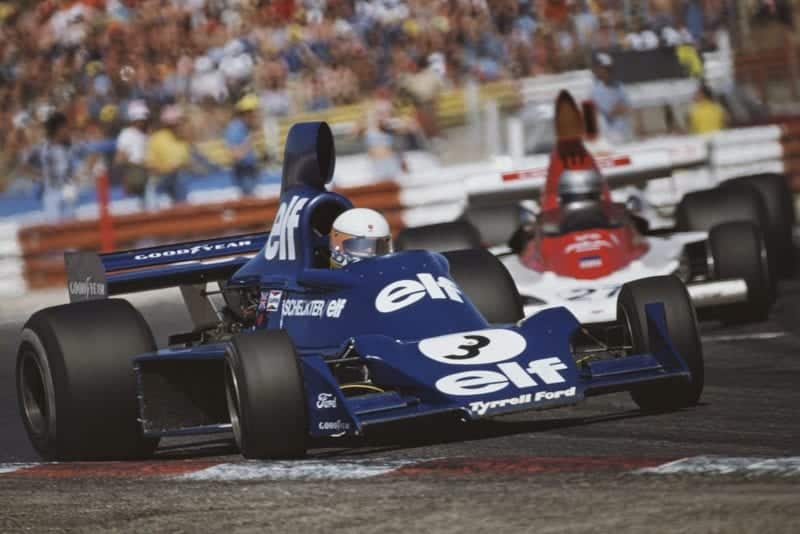
Jody Sckeckter put his Tyrrell on pole
Motorsport Images
There was no lack of activity during the two days of practice and some drivers covered more than the race distance on each day, but whether it did them much good is debatable, especially when Lauda pulled out his two very fast laps just when it was all over. As so often happens in the South of France there was a strong wind blowing off the mountains and sometimes it would be following the cars down the straight and other times it would turn across the straight, all of which was calculated to upset driver’s mechanical judgement of what gear ratios were best, or how steeply the aerofoils should be adjusted. On Sunday morning, during the 30 minutes of untimed practice, conditions were different yet again and the wise ones kept their adjustments to the known circumstances of Friday and Saturday, while others were frantically fiddling with things and in most cases getting in a muddle.
Race
The Grand Prix was due to start at 2.30 p.m. and the very hot weather made the wait seem interminable; but eventually the national races were over, lunch had been taken and the Formula One cars set off on their warm-up lap, though with the high ambient temperature there was not much need for warming things up. With Migault unable to start, twenty-five cars lined up on the grid, with Lauda and Scheckter on the front row, the Ferrari driver having chosen the left-hand side of the road. In the third row Pryce was already in trouble, his clutch dragging badly and he was holding the car back on the brakes. Lauda and Scheckter were side-by-side down to the fast ess-bend, but then the Ferrari went through without lifting and it was all over. Even as they returned up the back straight the Ferrari was pulling away impressively, and after twenty-four cars had gone by the travelling marshal’s Porsche 911 appeared and a little while later Tom Pryce’s Shadow as he had made a complete nonsense of the start with his feet on the wrong pedals when the flag fell. At the end of the opening lap Lauda had nearly two seconds lead over Scheckter, which does not sound much, but at racing speeds meant that he was almost out of sight of the rest of the field. Scheckter could neither hold the Ferrari round the corners nor down the straight and apart from being mentally depressed by this realisation, he did not feel confident about the handling of the Tyrrell and like so many drivers today he is not one to overcome adversity, preferring to set his pace to a safe appraisal of the conditions. This meant that he was holding up Hunt, Mass, Pace, Regazzoni, and Brambilla and allowing Lauda an even easier time to increase his lead. By lap three the Ferrari was four seconds ahead and Regazzoni was moving up past the queue behind Scheckter, but not for long as the Ferrari engine blew up at the end of lap 6 when the swarthy Swiss had taken third place from Hunt. Already Pryce had disappeared when the drive to his rear wheels failed, the dragging clutch being a forewarning of worse to come. Scheckter was still holding on to second place, but not for long and Hunt went by on lap 8 and Mass then began to look for a way by the Tyrrell. Pace lost his fifth place when he had to stop at the pits to have a misfire cured, and Brambilla had retired with a broken rear spring unit.
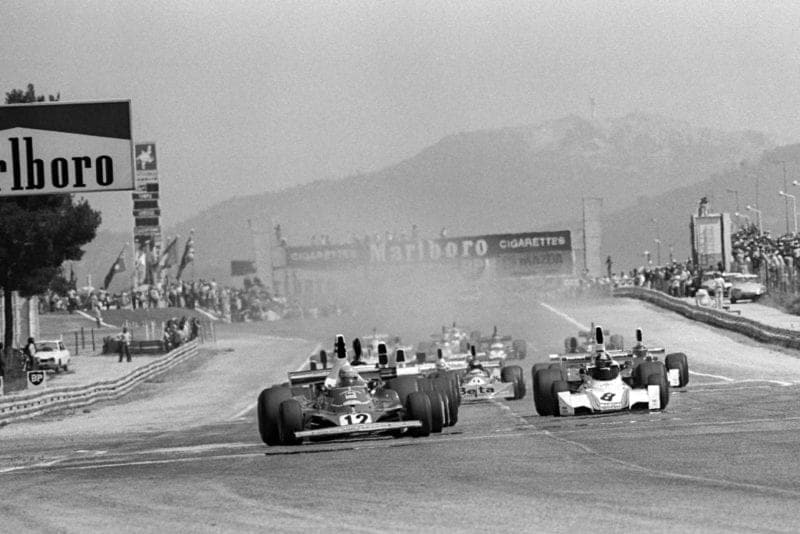
Lauda takes the lead as the field heads down to the first corner
Motorsport Images
Although the outcome of the race had been decided on the opening lap, providing the Ferrari did not give trouble, it was ten laps before the rest of the runner’s really sorted themselves out. Hunt pulled well clear of Scheckter, but made no impression on the leading Ferrari. Lauda looking extremely confident and able to set his speed to match any circumstances behind him. Scheckter in third place had the two McLarens of Mass and Fittipaldi close behind him and then came Jarier, who had made a very bad start from the second row. Next was Brise closely followed by Andretti, Reutemann, Peterson and Depailler. It took four laps for the McLaren pair to find a way past the Tyrrell, and then Scheckter was being pressured by Jarier, Brise and Andretti. Depailler got past Peterson and began to work hard to make up for a rather indifferent opening lap, driving with visible effort and enthusiasm that his team-mate lacked. lckx departed quietly from the scene when a driveshaft universal-joint broke and by 20 laps the scene was a bit processional and Lauda was about to lap Lella Lombardi, who was tailing along at the back of the field. Apart front Jarier finding a way past Scheckter, and Depailler overtaking Reutemann nothing much happened between laps 20 and 30, though Andretti overtook Brise on lap 28, at about the same time that Pace retired with a broken driveshaft joint.
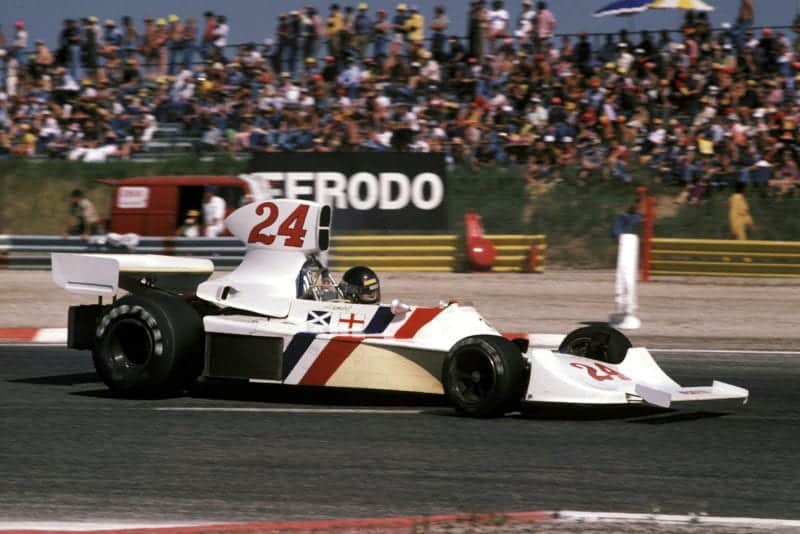
James Hunt finished an impressive 2nd
Motorsport Images
Out in front Lauda was running the race as he pleased, the overall pace being more than three seconds slower than in practice, but he merely kept about six seconds between himself and the pursuing Hesketh. In third place, Jochen Mass was driving splendidly, keeping in front of his team-leader and gaining steadily on Hunt. In fifth place was Jarier, somewhat disgruntled as he had hoped to win his own Grand Prix, and on lap 30 Scheckter found himself down in eighth place, behind Andretti and Brise, and it was clear that Depailler would soon relegate the South African to ninth place.
The only interest now lay in the fact that Mass was pulling away from Fittipaldi and was close behind Hunt, and the McLaren and the Hesketh drivers were urging each other along so that they were closing up on the leading Ferrari. There was no actual danger for Lauda, even though the Ferrari was developing more understeer on some corners than was desirable, as the full load lessened and the tyres wore down. Mass could see no hope of getting by Hunt, but that did not deter him from pressing hard. There was no “professional attitude” of settling for third place for the young German, he just drove harder and harder, hoping Hunt would make a mistake or the Hesketh give trouble, but neither eventuality took place. At the back of the field Laffite was really enjoying himself in the Williams as he was right up behind Peterson, who had been driving about as enthusiastically as Ickx. As Laffite got by, the Swede woke up and his pride got the better of his “professional attitude” and he re-passed, but Laffite would not give up and he gave Peterson a bad time right through to the end of the race. Reutemann had been running in front of them, rather disconsolately, but decided he had worn out his rear tyres and stopped to have them changed.
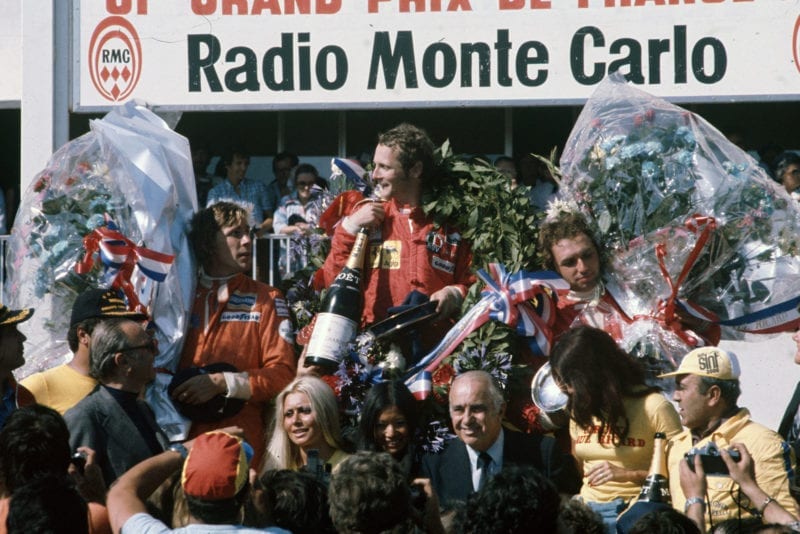
Niki Lauda on top the podium after winning
Motorsport Images
The Mass/Hunt pursuit race enlivened things no end, even though the outcome was never in doubt, and though they closed the gap to the Ferrari to less than three seconds, Lauda was never worried, knowing full well the situation and with plenty in hand.—D.S.J.
Results :
: FRENCH GRAND PRIX—Formula One-54 laps—Paul Ricard Circult-5.81 kilometres per lap 313.74 kilometres —Very hot
